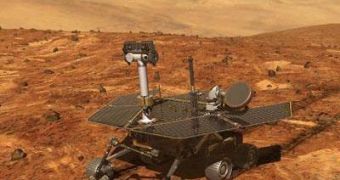Two of NASA's rovers present on the surface of Mars experience instruments failure after four years of activity. Though the original mission in which the rovers, Opportunity and its twin Spirit, were supposed to study the surface of the Red Planet was scheduled for only 90 days, NASA managed to extend it to almost four years since their arrival in January 2004.
The Opportunity rover has recently been crippled and blinded as a result of the problems experienced with two of its most important probing instruments. The rover's rock grinding tool and its infrared spectrometer used to study the Martian soil. The mission was limited to only 90 days, for fear that the solar panels used to harvest the solar power to convert itto electric energy would be blocked due to the accumulation of dust on their surface as a result of dust storms, greatly reducing their energy gathering capabilities.
But the surface of the solar panels were frequently cleaned by mild gusts of winds and NASA decided to extend its mission. Spirit, the twin of the Opportunity rover, stationed on the other side of the planet, explores an area in which the gusts of wind are not powerful enough to efficiently clean its solar panels. As a result the rover cannot accumulate sufficient energy to run all its instruments, so it frequently needs to access different slopes to maximize the amount of solar radiation hitting its solar panels.
However, though the rovers could in theory drive along the Martian surface for an unlimited time, since the energy problem is mostly solved, the aging components are now showing fatigue. The rovers have previously suffered several parts failures during the years, but have managed remain functional. In March 2006, the Spirit rover experienced a motor failure to one of its wheels situated on the right front. Since then the rover has been driving in reverse, dragging the dead wheel to compensate for the problem. The rover Opportunity has a similar problem to its right front wheel, but though the motor is still working, the system used to turn the wheel in certain directions has failed. Nevertheless the rover can still drive relatively well since it has another three directional wheels to compensate for the problem.
In November 2005, Opportunity has lost one of its probing tools, due to a motor malfunction causing it not to produce enough torque to move one of the arms. Both the rovers suffered several problems with the rock grinding tools, which were used to study the interior of rocks by cutting the top layer of its surface. The encoders with which the rock grinding is equipped, causing these malfunctions, have been eventually bypassed through software fixes, enabling NASA to continue exploiting the rock abrasion tools (RAT).
Aside from the series of problems with certain components, now the rovers are again hunted by the dust problem. The infrared spectrometer used to study the chemical composition of rocks was blinded by high amounts of dust, but the team operating the vehicles hopes they will solve the affected part by jiggling it, in the effort to shake the dust off. In the meantime, the other camera and instruments are working normally.
The rover Spirit is facing a relatively hard winter, as a result of the amount of dust accumulated on its panels and the fading light which threats to deplete its power supply. Nevertheless, the vehicle is now on its way towards a close slope that will probably ensure a good angle to receive more sunlight.
Though the two rovers have several tools out of function, NASA says that they will continue to keep the vehicles alive as much as possible, since they've become essentially effective robotic geologist, that could still provide crucial data.

 14 DAY TRIAL //
14 DAY TRIAL //